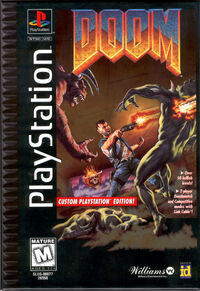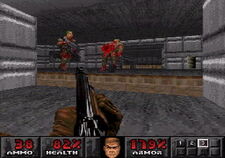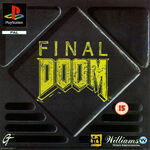
The PlayStation port used different box cover art to other versions.

A screenshot from the PlayStation version of Doom

Box cover for the PlayStation version of Final Doom.
The Sony PlayStation version of Doom was a conversion of Doom and Doom II by Williams Entertainment. It was released on November 16, 1995 and ran with a modified version of the Doom engine used in the Atari Jaguar port. Final Doom's PlayStation version was also released by the same team in late 1996.
Multiplayer was unusual in that splitscreen was unavailable; two consoles had to be linked together instead. This made the multiplayer truer to the original, but it was done at the sacrifice of accessibility. Presumably two players (or more) running on one console would reduce the speed of the game dramatically.
The Final Doom conversion onto PlayStation used the same engine and team who brought Doom and Doom II onto PlayStation. It was released in October of 1996. It included a mixture of 30 levels from Master Levels for Doom II, TNT: Evilution, and The Plutonia Experiment. The instruction booklet, however, erroneously states within that the game contains 30+ levels. Although the box does not mention the Master Levels, the back cover of the instructions indeed acknowledges their inclusion. It also has support for the PlayStation Mouse which the former did not.
John Romero is quoted on the back cover, calling this the "best DOOM yet" and is credited as "Creator of DOOM".
Gameplay
The game has enhancements, updates to the graphics engine, including higher color depth, alpha blending and colorized sectors.
Like the Jaguar version from which it was based, it contains extensive changes to the map geometry for many levels, mainly for performance reasons. Most notable is that a room is kept with a small usage of textures. Maps with large vertical distances also suffer modification. However, most of the geometry changes are only present in maps from Episode 1 - 3 of the original Doom, since these were taken directly from the already-simplified maps used in the Jaguar port; maps taken directly from the Ultimate Doom's Episode 4 and Doom II tend to feature very few geometry changes compared to the originals. There is noticeable slowdown in some Ultimate Doom and Final Doom levels, particularly when using the highest difficulty settings.
The game uses a significantly less amount of enemies, especially the Cyberdemon and the Spiderdemon, which appear less frequently in order to achieve a much more imposing presence (a counter-part to the PC versions where they are used in map tricks). There is no Arch-vile (because he had twice as many animation frames as the other monsters, and the developers "just couldn't do him justice" on the PSX) and the Icon of Sin is not in the game (instead, the final level "Redemption Denied" contains multiple Barons of Hell and one or two Spider Masterminds depending on the skill level).
However, the game includes all enemies, weapons and items of Doom II in early Ultimate Doom levels, including the first episode. Added was a type of Spectre, the Nightmare Spectre. The regular Spectre looks like a partially invisible Demon, whereas the Nightmare Spectre is dark green and tougher.
Exclusive levels
- MAP16: Hell Gate (from Jaguar Doom)
- MAP17: Hell Keep (from Jaguar Doom, entirely different map from PC version)
- MAP29: Twilight Descends
- MAP30: Threshold of Pain (final level of Ultimate Doom)
- MAP54: Redemption Denied (final level of Doom II)
- MAP57: The Marshes (secret level, entrance from Twilight Descends)
- MAP58: The Mansion (secret level, entrance from The Suburbs)
- MAP59: Club Doom (super secret level, entrance from The Mansion)
Removed Doom levels include Hell Keep, Slough of Despair, Dis, Warrens, They Will Repent, Against Thee Wickedly, And Hell Followed, and Fear. Removed Doom II levels include Downtown, Industrial Zone, Gotcha!, The Chasm, The Spirit World, The Living End, Icon of Sin, Wolfenstein, and Grosse.
Differences between PlayStation and PC version
- Largely pre-recorded ambient background music for all levels using a simplistic form of wave sequencing, rather than wavetable/MIDI generated audio. Aubrey Hodges created the music and reused certain songs (the symphonic rock/metal theme, most noticeably) in Doom 64.
- The sound effects are different to the PC version, and were reused in Doom 64. Said sound effects also have echoed effects in closed-off parts of the levels (any area with a ceiling).
- To optimize the game for the Playstation, some map areas were simplified and some textures were reduced in size. Also, some animations had frames cut.
- No Arch-vile and Icon of Sin enemies.
- Faster frame rate, causing the game to move much quicker than its PC counterparts.
- Different status bar. The one used in this game has a darker tone (more black rather than gray in the original) and does not feature the listing of the remaining ammo of all types on the right side like the original.
- An added status bar face gib animation.
- The Super Shotgun has a different appearence in the North American and European versions of Final Doom.
- The I'm too young to die skill level is renamed I am a wimp.
- There is no Nightmare! skill level.
- There are fewer computer screens.
- Different cheat codes.
- Passwords are used for loading; while they store numbers as map level, skill level, health, armor and ammo, the numbers for the latter three tend to be rounded. No Memory Card usage.
- Health and armor bonuses are worth 2% instead of 1%.
- Characters and weapons from Doom 2 are added.
- A new monster, the "Nightmare Spectre" was created for this port; it appears a bit larger in size than the original Spectre, dark green in color, and is twice as hard to kill.
Bugs
- A rocket launcher blast originating from a player's rocket launcher shot does not do any damage to him/herself whenever he/she is facing a corner where the walls are aligned in an angle of 90 degrees. The player must also be facing slightly off the corner's edge and be as close to it as possible. A series of images demonstrating the phenomenon in the Final Doom level Crater can be viewed here: [1] [2] [3] [4]
- A glitch where the screen becomes black and the text "TEXTURE CACHE OVERFLOW" is displayed may occur. [1]
- Occasionally, monsters may enter into a wall, at which point they can still be heard, and may be seen firing their weapons, but otherwise they cannot interact with player nor be destroyed. If viewed for a while, the trapped monsters may start retreating into the distance. Most commonly experienced with zombie soldiers and Lost Souls. The glitch can occasionally be triggered by shooting directly at a monster with a weapon that doesn't kill them instantly but knocks them back (i.e. a shotgun fired at a Lost Soul, but from far enough away that it doesn't kill it instantly).
- If a huge number of monsters are on screen at the same time (which is possible on numerous levels), the game has been known to crash. This is particularly a danger when playing the level Suburbs on high difficulty due to the fact it's possible for literally dozens of monsters to not only be on screen at the same time, but also infighting with each other, causing the first-generation PS console's memory to overload.
Inaccessible secrets in Final Doom for PlayStation
- In Level 9, Nessus, there is a walkthroughable (transparent thickness) wall, with a Revenant behind it (on the harder difficult levels: may be a different enemy on lower levels). On this ledge -- which is above the corridor containing the four teleport pads -- there is a megasphere and, around the corner, the BFG9000. Many cannot get onto this ledge, but, for those that do, the BFG9000 in the top right-hand corner can (with difficulty) be taken, but because you cannot physically enter the area it resides in, the game never reports you as having found that secret.
- In Level 29, The Death Domain, there is a switch missing which prevents the player from being able to access an area on the west side of the map.
All other secrets are fully accessible.
PlayStation Doom TC
A total conversion was released by fenderc01.
External links
- Sony PlayStation official site
- Information about the Doom / Doom II PlayStation port on ClassicDOOM.com
- Information about the Final Doom / Master Levels PlayStation port on ClassicDOOM.com
- http://5years.doomworld.com/interviews/harryteasley/
- PlayStation Doom TC
| Doom for Sony PlayStation
Template:S-aft Template:S-aft |
